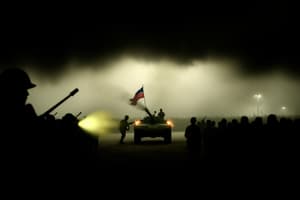Podcast
Questions and Answers
Explain the Tet Offensive.
Explain the Tet Offensive.
On January 31, 1968, 70,000 North Vietnamese forces launched a coordinated series of attacks on more than 100 cities and towns in South Vietnam, beginning on the night of January 30/31, which was the Vietnamese New Year.
What happened militarily during the Tet Offensive?
What happened militarily during the Tet Offensive?
The North Vietnamese and Viet Cong took the Americans by surprise and attacked cities and villages all over the South, including the capital of Saigon.
How did the Tet Offensive change opinions about the Vietnam War in America?
How did the Tet Offensive change opinions about the Vietnam War in America?
The American public began to turn against the war, seeing it as unwinnable, largely due to the failure of American forces during the Tet Offensive.
How did violence at home in the U.S. mirror violence in Vietnam in 1968?
How did violence at home in the U.S. mirror violence in Vietnam in 1968?
To what extent was Nixon's program of 'Vietnamization' a plan for 'peace with honor'?
To what extent was Nixon's program of 'Vietnamization' a plan for 'peace with honor'?
Despite the gradual withdrawal of U.S. forces, how did the war continue to outrage the nation?
Despite the gradual withdrawal of U.S. forces, how did the war continue to outrage the nation?
Flashcards are hidden until you start studying
Study Notes
Tet Offensive Overview
- On January 31, 1968, 70,000 North Vietnamese conducted coordinated attacks on over 100 cities in South Vietnam.
- The offensive coincided with the Vietnamese New Year, taking advantage of a temporary truce to surprise American forces.
Military Actions and Outcomes
- American and South Vietnamese forces were caught off guard, leading to assaults even in Saigon, the South Vietnamese capital.
- After a month of intense fighting, control was regained by Americans and South Vietnamese, marking the offensive a military failure for North Vietnamese forces.
Shift in Public and Government Sentiment
- The failure of the Tet Offensive contradicted U.S. government assurances of a war nearing its end, intensifying public opposition.
- The media began portraying the Vietnam War as unwinnable, contributing to growing unrest.
- President Lyndon Johnson announced he would not seek re-election later in 1968, a decision influenced by the war's failures.
Domestic Violence and Social Unrest
- Following the Tet Offensive, the assassination of Martin Luther King Jr. sparked protests and riots in over 100 cities.
- Violence persisted with the assassination of Robert Kennedy, reflecting domestic tensions paralleling the ongoing Vietnam conflict.
- The Democratic National Convention saw protests demanding an antiwar platform; confrontations with police highlighted the depth of social unrest.
Nixon’s "Vietnamization" Strategy
- Nixon's "Vietnamization" aimed to replace American troops with trained South Vietnamese soldiers to defend against the North.
- Intended as a "peace with honor," the strategy sought to maintain a viable South Vietnam as the U.S. withdrew, though it faced skepticism regarding its effectiveness.
Continuing Outrage Over the War
- The My Lai Massacre in March 1968 involved a U.S. platoon killing hundreds of civilians, leading to outrage when only Lieutenant Calley was convicted, serving a short sentence.
- The Kent State Shooting in May 1970 resulted in the National Guard firing on student protesters, killing four, exacerbating national divisions and anger regarding the Vietnam War.
Studying That Suits You
Use AI to generate personalized quizzes and flashcards to suit your learning preferences.




